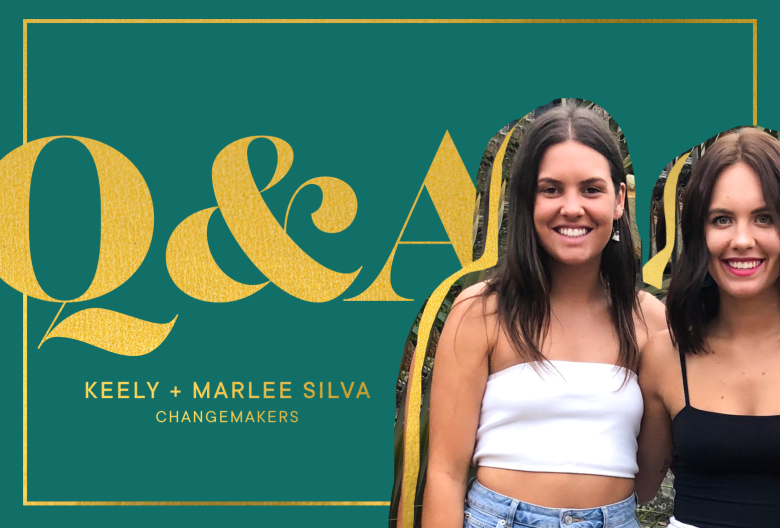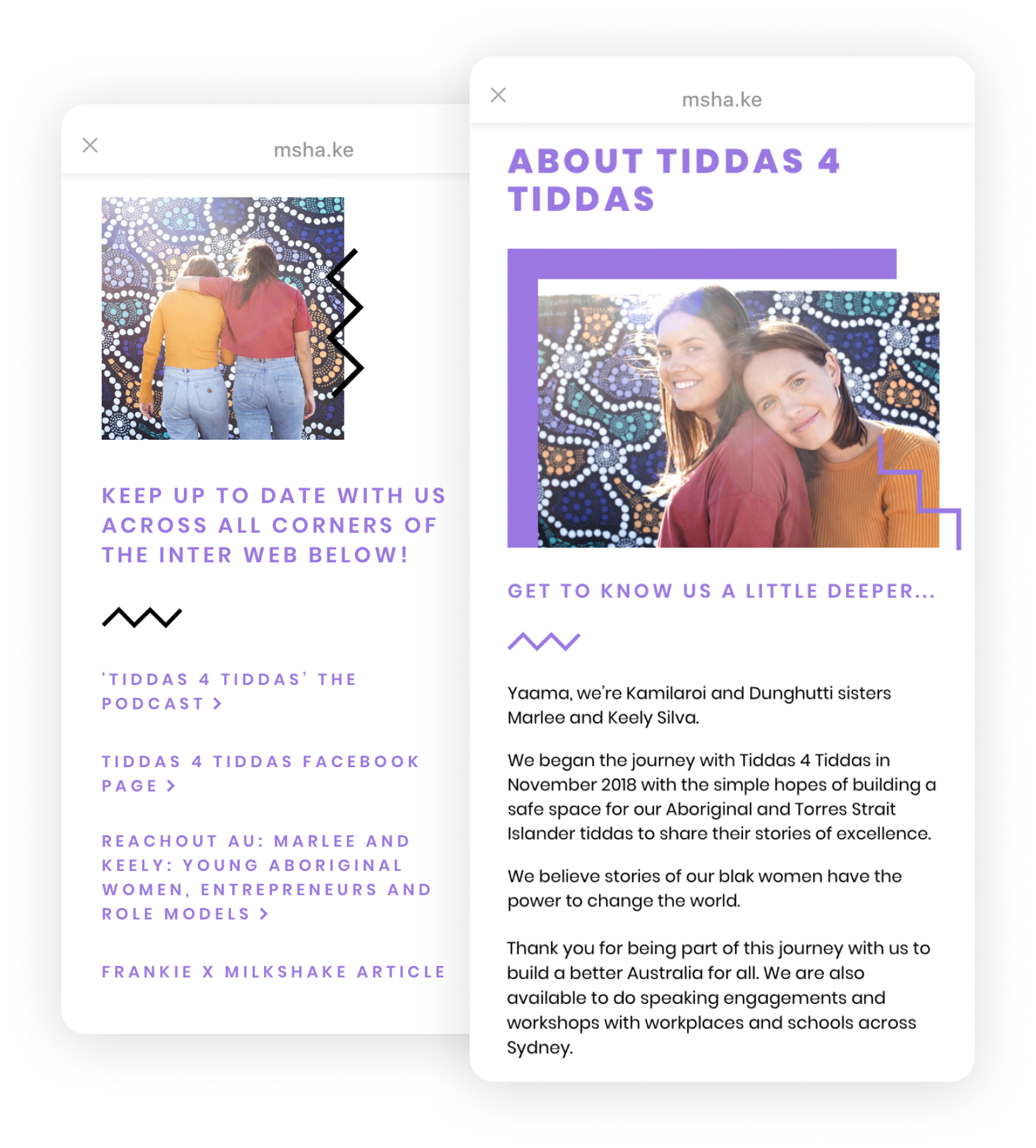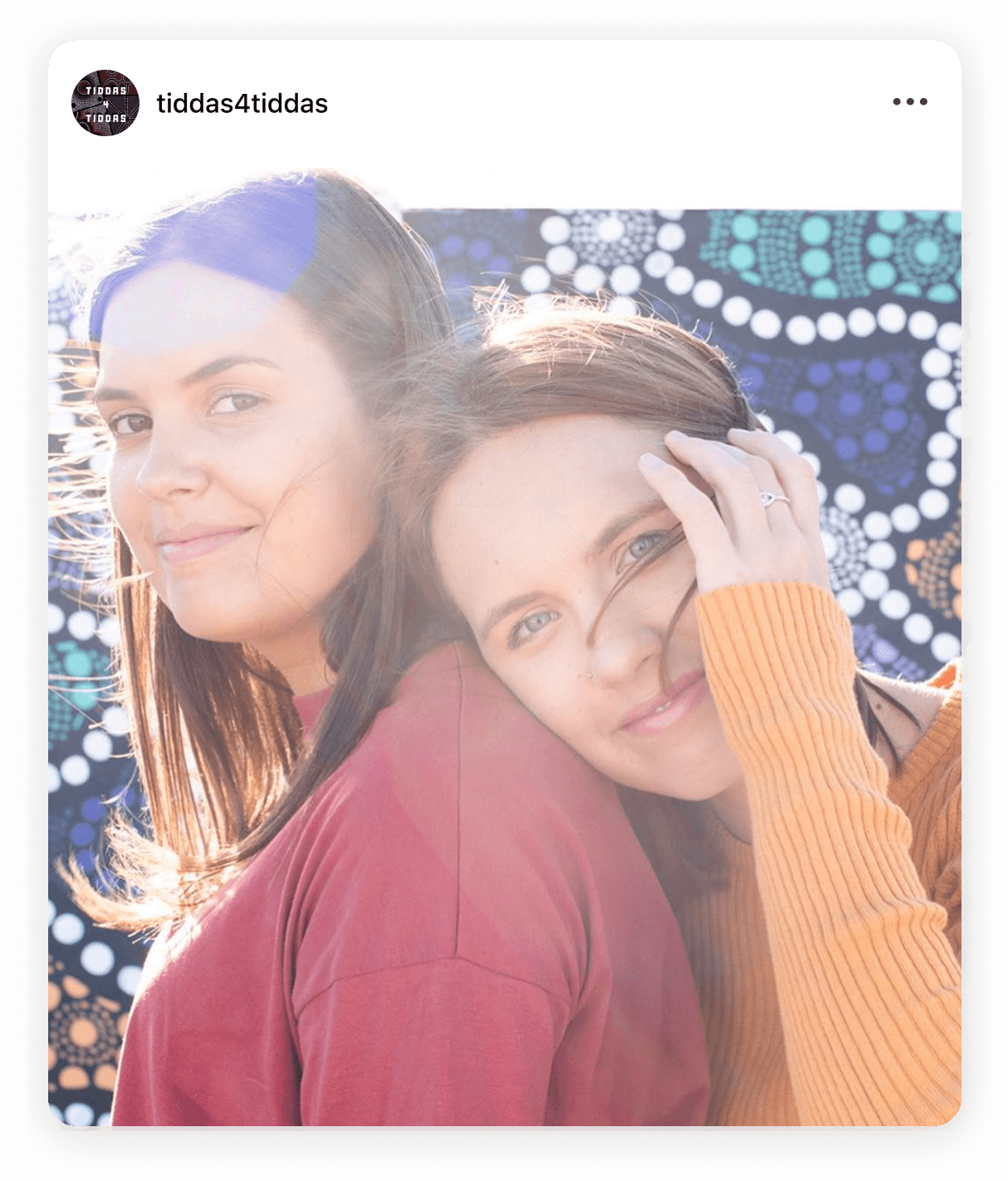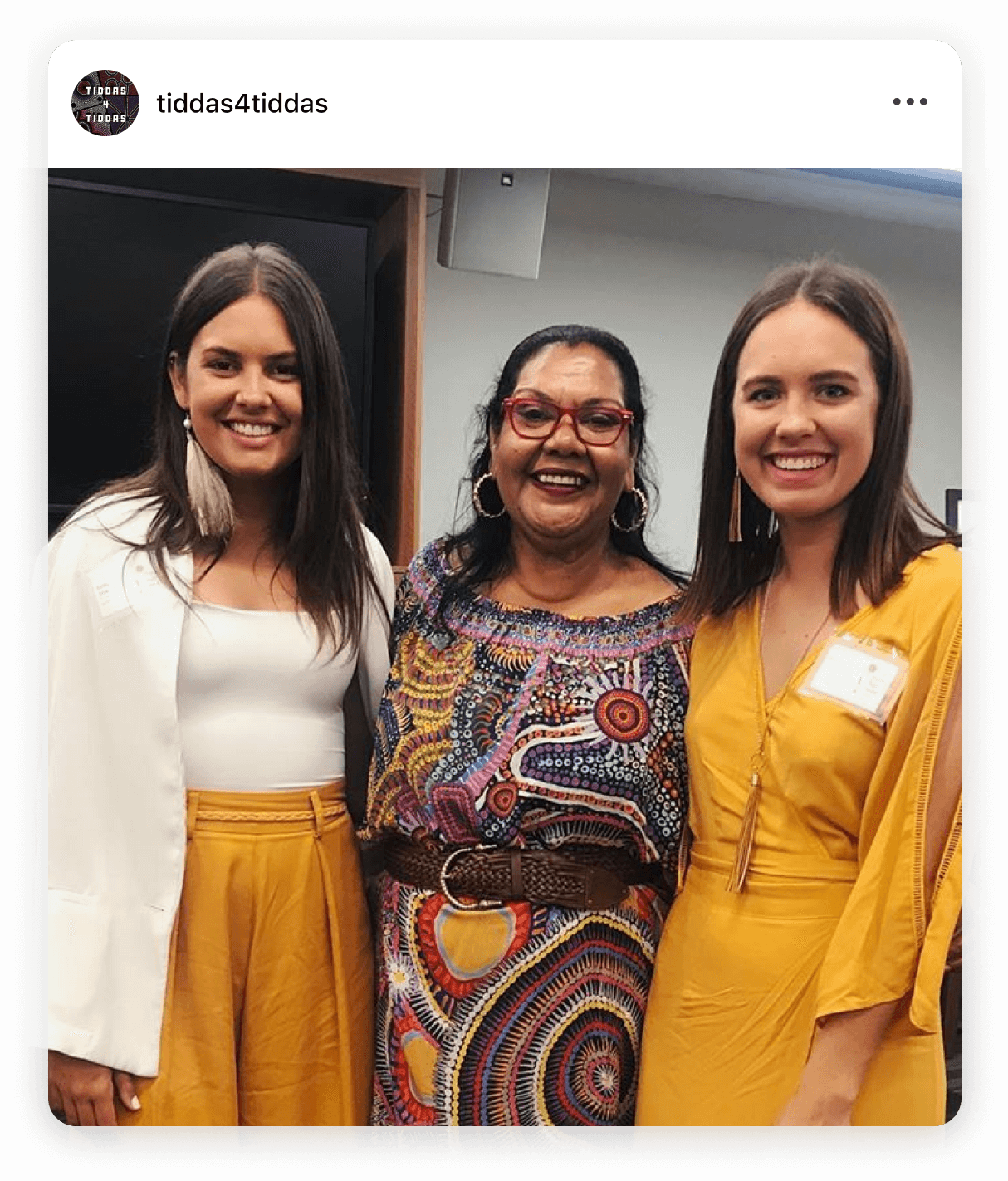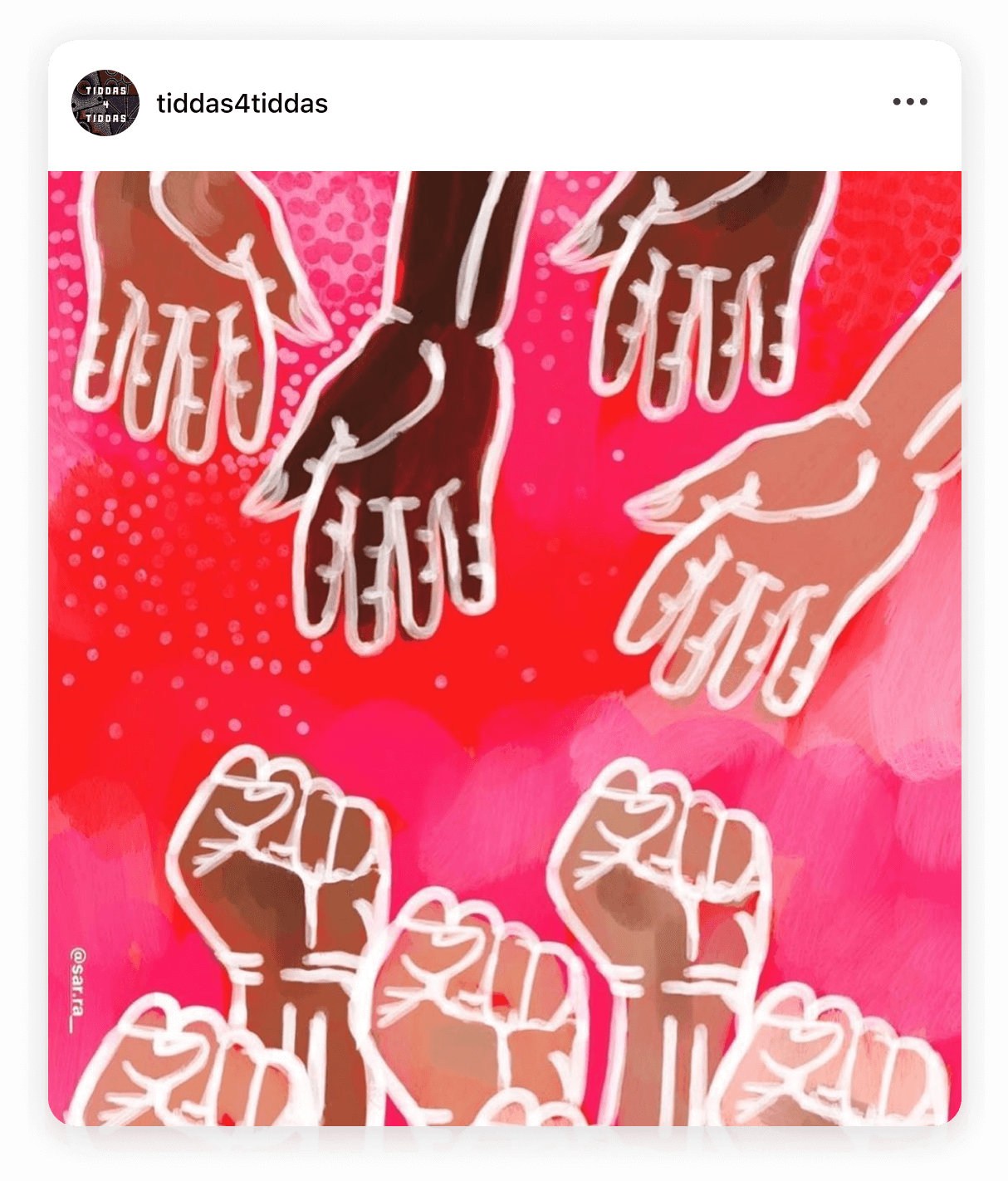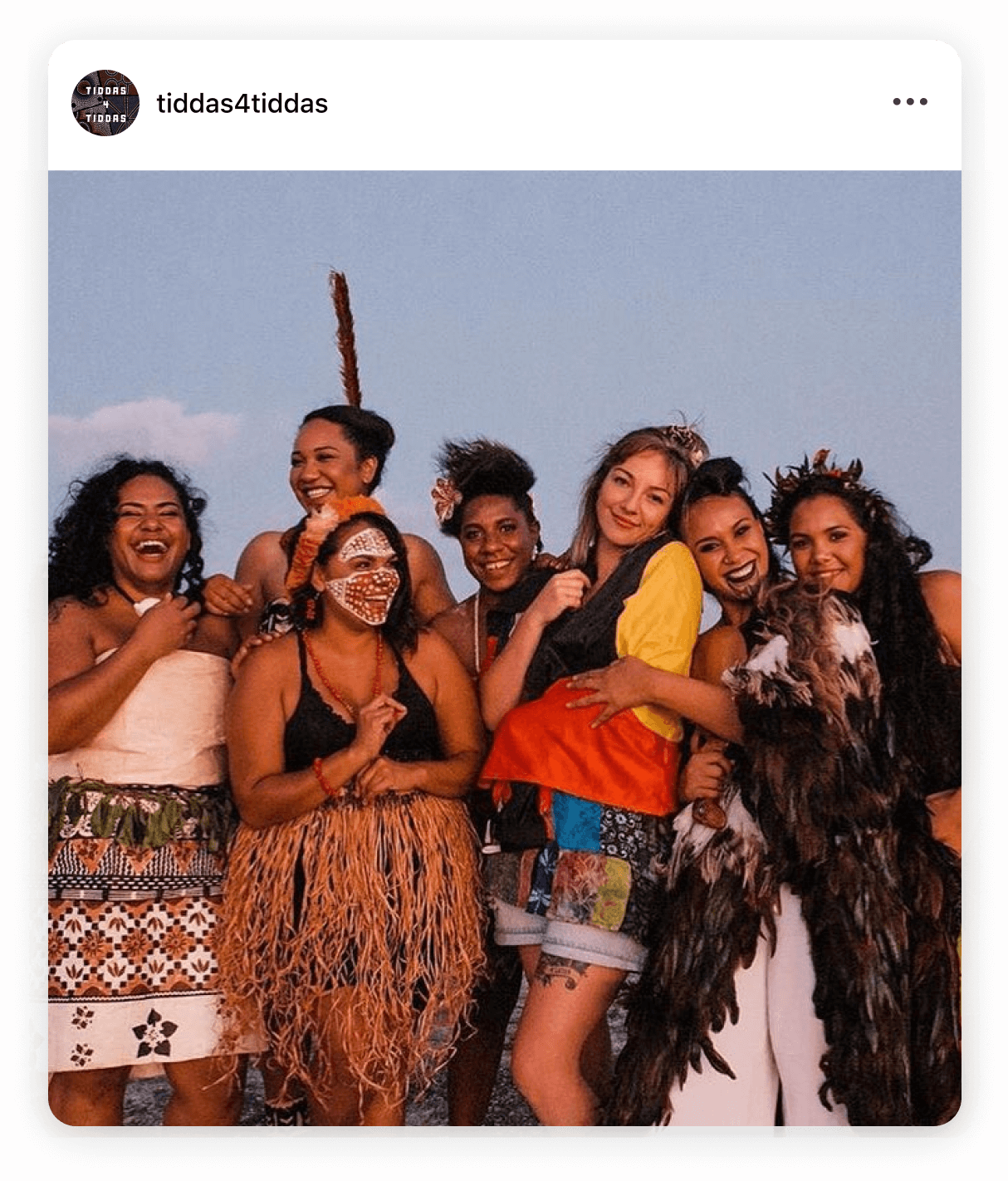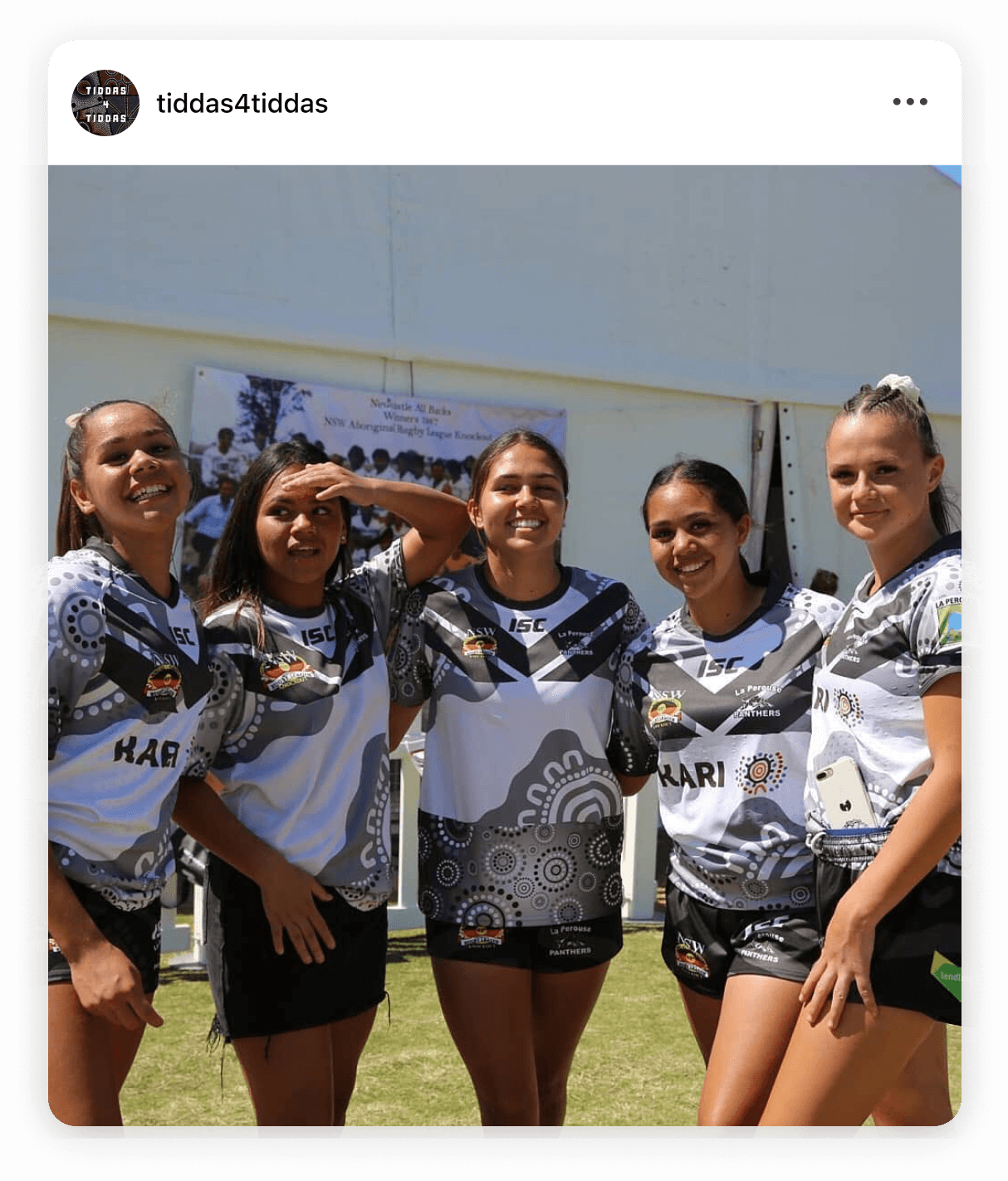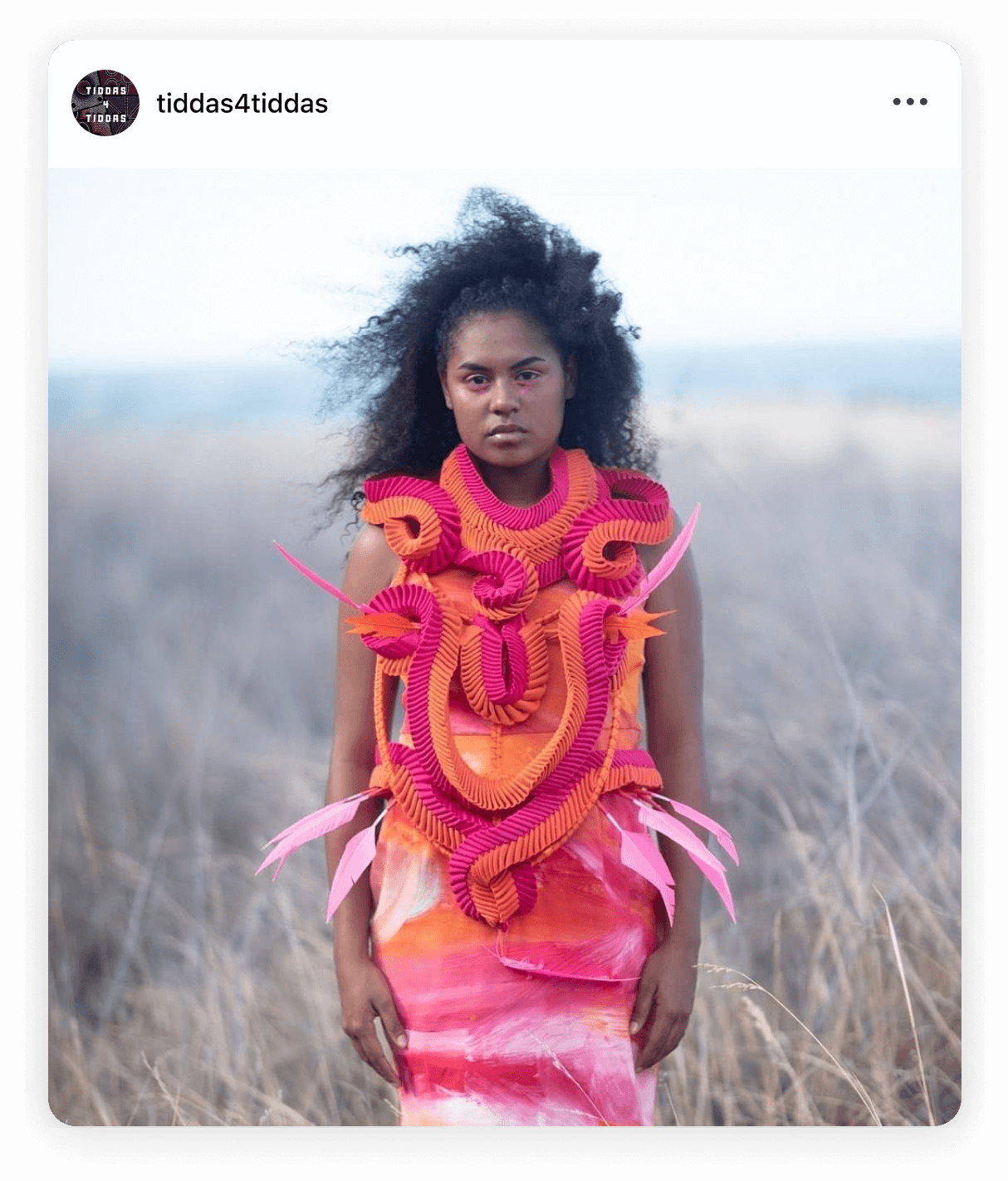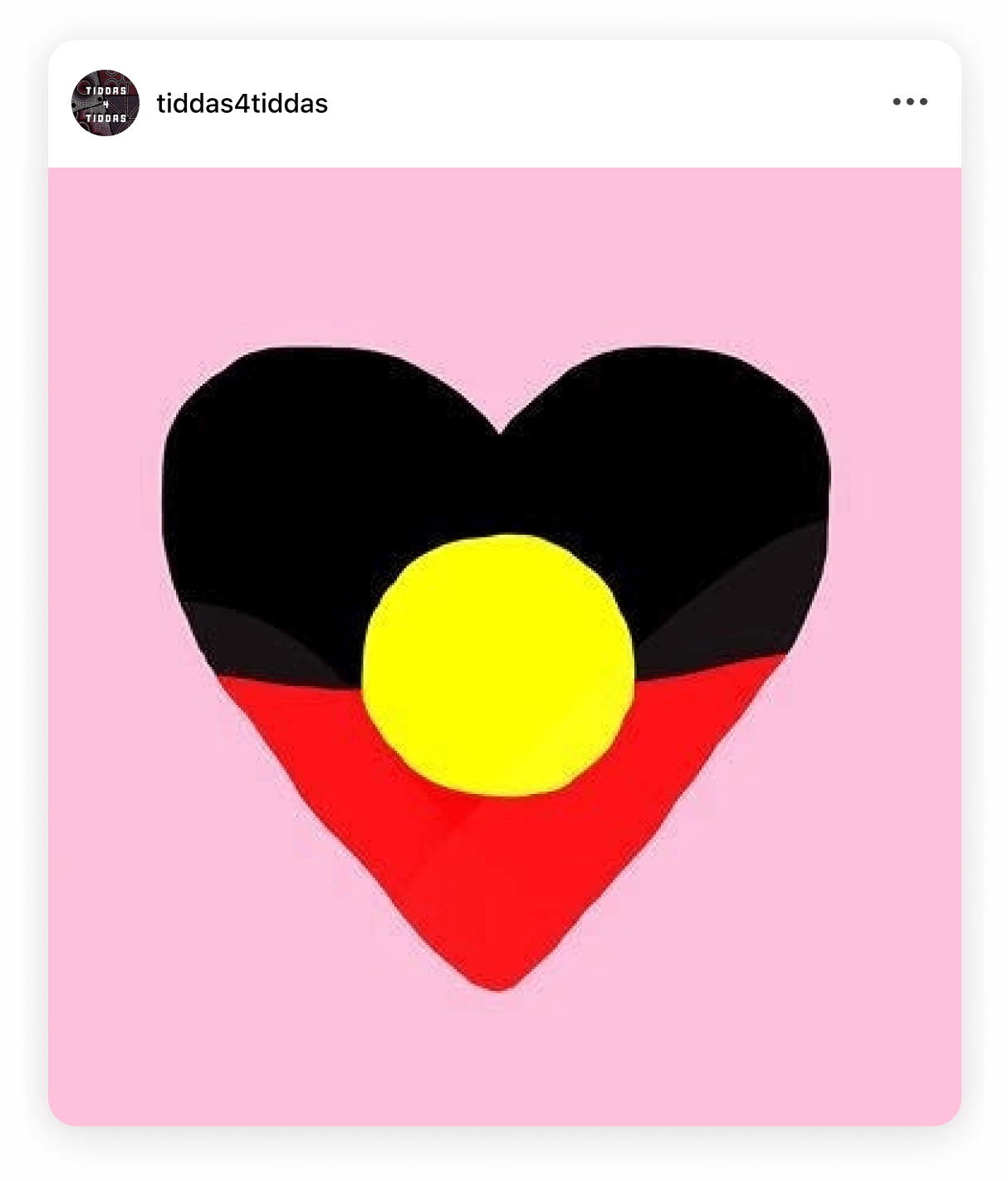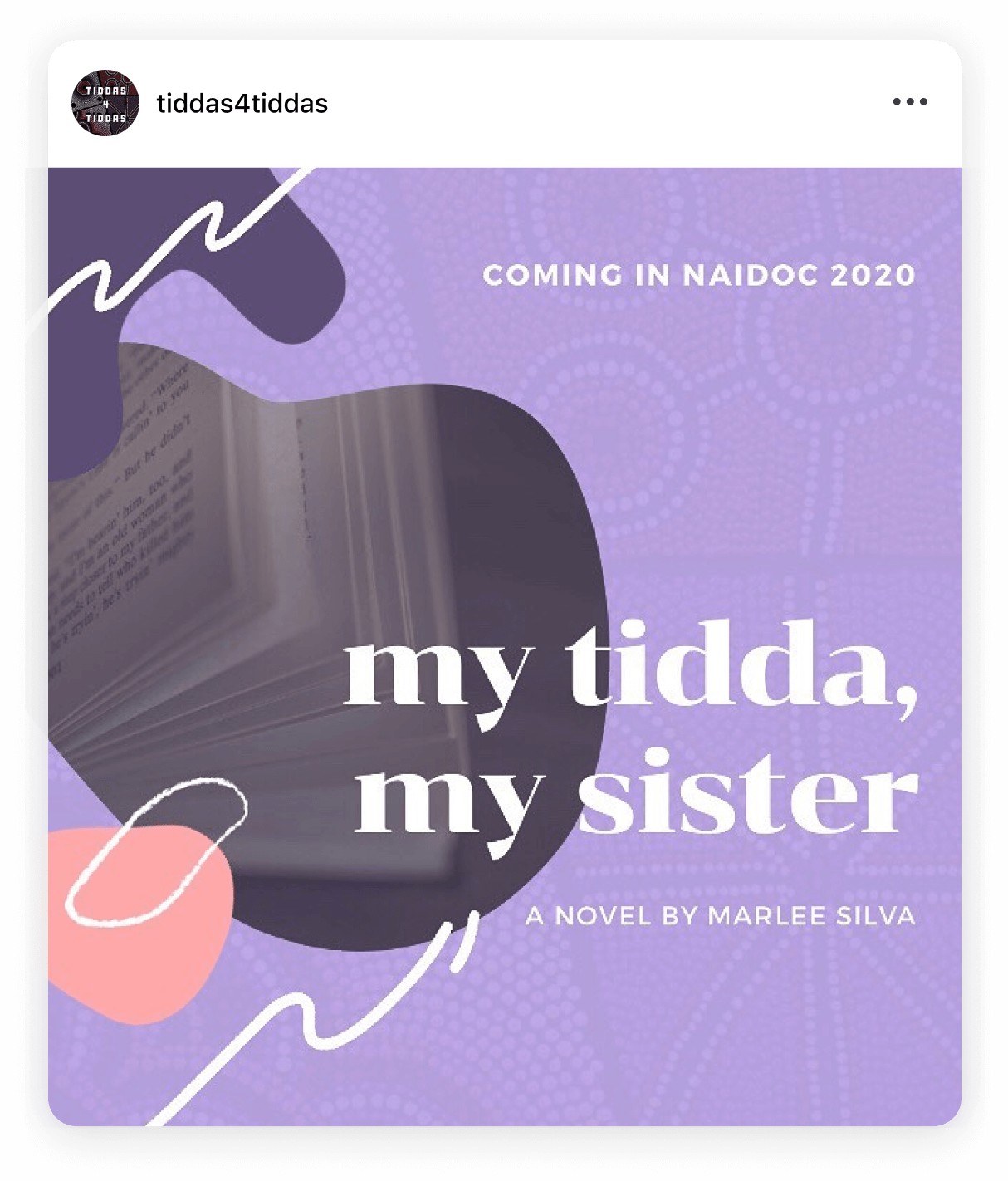Dreamt up by Kamilaroi sisters Marlee & Keely Silva, @tiddas4tiddas is the inspirational Instagram account empowering young Indigenous women to succeed.
Growing up with a lack of cultural representation both online and in their day-to-day lives, Marlee & Keely wanted to create a platform over which Aboriginal women had complete ownership – a close-knit online community and safe, supportive space that they themselves craved as young Indigenous women.
Now a thriving online community, @tiddas4tiddas is celebrating the incredible stories, accomplishments and achievements of amazing Aboriginal women to inspire, empower and educate people every single day.
We sat down with passionate changemaker and one of the incredible founders behind the scenes – big sis Marlee Silva – to hear + celebrate her story, and find out how she’s changin’ the world one tidda at a time…
How did @tiddas4tiddas come about?
Tidda is an Aboriginal slang word meaning sister. So, Tiddas4Tiddas translates into sisters for sisters. It was inspired last year by the 2018 NAIDOC theme. NAIDOC week is essentially the premier Aboriginal celebration of the year, and what I think of as the black Christmas in July. Each year it has a theme, and the theme was ‘Because of her we can’.
It was all about our women with a focus on sharing stories of our aunties, our grandmothers and all the women throughout our history who were on the front line. The ones who would come home and feed five kids, the ones who didn’t get as much of the spotlight in the past. They were front and centre for the whole of 2018.
What motivated you to start posting on Instagram?
So it got to the end of that year and I started to get a little bit scared of what would happen once it finished. I’d seen all these amazing things, all these stories that were inspiring me every day that I got to see on various media platforms. But, there was no place that existed specifically just for Aboriginal women online, which is where most of us get our news and is such a massive place for education.
“I’d seen all these amazing things, all these stories that were inspiring me every day that I got to see on various media platforms. But, there was no place that existed specifically just for Aboriginal women online, which is where most of us get our news and is such a massive place for education.”
Something people don’t realise is that Aboriginal and Torres Strait Islander people are actually the highest users of social media in the country. There might not be a lot of computers in some of our remote communities, but everyone has a mobile phone. When you’re nine hours apart, the best way to connect with each other and keep up to date is obviously with Facebook and Instagram.
So knowing that information and not wanting to lose the momentum of ‘because of her we can’, I just kind of woke up one day with an idea to create that space that I wanted as an Aboriginal woman to have in my Instagram feed. A place that was going to be inherently positive, celebrating the women that I knew and any other women that we could connect with, for what they were doing every day.
How did you make your vision a reality?
I proposed my idea to Keely across the breakfast table. I basically said, ‘I have this idea, and you’re gonna do it with me’ – I have some crazy ideas, so she didn’t really think much of it and neither did I.
About three days after the initial conversation, we started the Instagram page and had 1,000 followers within a week. Instantly, we had so many women that we’d never met personally reaching out to share their stories. Everyone was so generous and vulnerable and fearless in the stories they told us, and I think it’s because they have a sense of ownership over the platform.
It’s not necessarily what we had in mind when we created it, but I’m really thankful. Because when you feel a sense of responsibility over something as a participant, you want to contribute to it and see it grow. It builds a really nice culture where everyone is unafraid to tell their story. Now, as the platform continues growing it’s not just Aboriginal women. There’s also men, non-indigenous people and those overseas supporting us too. Because of how we’ve set the standard, everyone supports everyone to tell their story.
“As the platform continues to grow, it’s not just Aboriginal women. There’s also men, non-indigenous people and those overseas supporting us too. Because of how we’ve set the standard, everyone supports everyone to tell their story.”
How do you overcome negativity online?
I treat it as a case by case thing. If there’s a comment that’s inappropriate, but not blatantly racist I’ll leave it on the post. And I’ll comment back, explaining why it’s inappropriate. But if it’s something that’s just straight up disgusting – block and delete.
Who is Tiddas for and what’s the purpose behind your content?
Our content is for everyone. I think that obviously means different things for different types of people.
For my fellow Aboriginal Torres Strait Islander sisters, it’s a place of inspiration and representation. You can’t be what you can’t see, so I think more than anything, we’re a presence. Particularly for our younger women, for them to see doctors and lawyers and politicians, and all different types of Aboriginal women killing it in every field. We just posted about a 14 year old girl who is a state champion boxer. I can’t stop thinking about her and it just makes me think, oh my gosh, I think I want to box!
“For my fellow Aboriginal Torres Strait Islander sisters, it’s a place of inspiration and representation. You can’t be what you can’t see, so I think more than anything, we’re a presence. Particularly for our younger women, for them to see doctors and lawyers and politicians, and all different types of Aboriginal women killing it in every field.”
For our community, it’s really about revealing that you can literally do anything. But for non-indigenous people it’s about education, and finding a way to be a part of the story. In order for us to build a brighter future for the whole country, we need to work together.
I guess the main purpose is for everyone to feel empathy, passion and joy in the successes of Aboriginal Australia. And for people to also carry the issues and the not-so-happy stuff that we talk about as their own. They’re Australian issues, not just issues for Aboriginal people to care about.
Aboriginal culture is something we should all be proud of. This beautiful country has such a rich history spanning thousands of years, no one else in the world has that. As we move forward as a country and look to our culture as a shining example of sustainability and storytelling, we will have true reconciliation.
What’s the most important thing that @tiddas4tiddas has achieved so far?
Undeniably, the reach that we’ve got has been an insane achievement and is completely organic – we’ve never paid for a Facebook ad or anything like that. And due to that reach, there’s so many young girls who reach out to us. It speaks to the hunger for something like this. A lot of young people just want it. Whether you’re Aboriginal and want something you can relate to, or you’re not and you want to learn more about Aboriginal culture, there’s just a massive hunger there which we couldn’t have anticipated.
For instance, one of Keely’s friends was working in regional Western Australia, so far away from us. He was at a pub talking to a girl who I don’t think was even Aboriginal. She was talking about Instagram and mentioned this really awesome page that he should follow called @tiddas4tiddas. And he turned around and was like, one of my best mates runs that.
How do you feel having so many young Aboriginal girls look up to you?
Even though sometimes I feel a little bit uncomfortable accepting it, I guess we’ve become role models. And because everything that we do is all about positivity and self love, I’m really proud that we’re spreading that. When I look at our analytics, our demographic is very spread out. Most of the women who follow us are 25 to 30, but I constantly think about the teenage girls – because we developed Tiddas from thinking about ourselves at that age, and what we would have benefited from. I just think of them scrolling through their Instagram feeds, and between the influencers and bikini shots, that sort of stuff can be so much pressure for a young woman. I like that we’re breaking that. If it makes one person stop and think, that’s great.
When you’re Aboriginal growing up, you get told that because you’re Aboriginal, you can’t do things or you’re not going to succeed, or that you’re going to live up to certain stereotypes. It’s exactly what me, my sister and far too many of the women that we know went through, and unfortunately this is still the case today. I think that for young women to not only see women that they relate to, but also seeing other people talk about how great they are has a lot of power in it.
Has Instagram changed the direction of your life and career?
Yes. in capital letters, YES! I had no idea that this “hobby” would become what it has. I’m sitting down with lawyers in a few weeks to talk about how we properly register ourselves as a business and things like that. And it’s like, how did that even happen?
It takes up a lot more of my life than I thought it would, and that’s in no way, shape or form a negative thing. I’m very happy about it! I’ve had to drop down to four days in my full time job because of everything that’s happening. I had a pretty clear idea of what I wanted to achieve in like a two year period essentially this time last year, and it’s just completely diverted from that. Which is really cool.
I’ve always been someone who trusts their gut. I’ve had a few opportunities pop up for me since I left school. In the past I’ve thought – okay, the universe has put this in front of me, so I’m going to do it. And it’s all led to this point. I feel like everything has happened for a reason so I could do this. It’s all up from here.
You pay so much respect to other people’s stories. How do you choose which stories to tell?
Well I’m a writer by trade. I studied creative writing, and was actually completing my honours when I started Tiddas. Storytelling is my greatest passion, and I put a lot of effort into every story that we do tell. I’ve never said no to someone who wants to reach out and tell their story. Not a single person. We’ve written something for every woman who has reached out.
“Storytelling is my greatest passion, and I put a lot of effort into every story that we do tell. I’ve never said no to someone who wants to reach out and tell their story. Not a single person. We’ve written something for every woman who has reached out.”
They might just send me a picture and a bit about who they are, but I tend to try and draw out a bit more and take quotes and learn a bit more about them, stalk them on socials a bit. Because a lot of the time, they don’t realise that they’ve already written something perfect. I spend a lot of time learning about them before I post. But then there’s other women who just make my life so easy and drop little gems into our DM’s completely ready to go, so that creative process is pretty straightforward.
When we’ve got bigger ideas to explore, I’ll think for a bit longer and map it out. I’m a big fan of Trello boards myself. I keep all the plans I have there, alongside my millions of journals filled with ideas. It’s all been something that I’ve been learning on my feet and figuring out as I go.
What challenges have you faced as young Indigenous women in your industry? How are you aiming to combat that?
I’ve only ever worked for Aboriginal organisations which means that, of course there are obstacles that you face, but they’re not inherently connected to my identity. Because most of the people around me have the same one.
We faced our biggest obstacles when we were in high school. We grew up in the Sutherland Shire, south of Sydney. Which is famous for race riots and is a highly populated Anglo-Saxon region. It was very rare to see anyone who was brown, let alone Aboriginal Torres-Strait Islander.
So we were it, and became the tokens at our high school in particular. Everyday we were fighting to justify our identity. Because when you don’t understand Aboriginal culture, you have a specific perception of what Aboriginal people look like. So we weren’t black enough or white enough for a lot of people. We also become the holder of all Aboriginal knowledge. As two Aboriginal kids, we were expected to know the entirety of our 80 thousand year history.
“Everyday we were fighting to justify our identity. Because when you don’t understand Aboriginal culture, you have a specific perception of what Aboriginal people look like. So we weren’t black enough or white enough for a lot of people.”
We had a choice between passing as everyday kids because of how we looked, or being the loud and proud Aboriginal people we were. We were the only example that most people around us had of Aboriginal Australia. So we decided to be the best possible example.
Because of the expectations put on on us as young teenagers, we had to grow up really fast. Which is of course only something you realise in hindsight. But from very early on, I had very well formed opinions and a very strong understanding of who I am and what aligns with my morals and my identity.
We know you already have an incredible podcast! Do you have any other creative projects in the works?
Yes. We’re working on something very exciting – essentially my life dream. I’ve been approached by a publisher to write a book! I can’t even believe it’s real. We’ll be turning some of the best stories we’ve received as well as others from history into a collection of short stories – entwined with bits of education, quotes and inspiration. I want it to be really bright and colourful, something that you want to pick up regardless of who you are.
I’m also about to start recording Season Two of the podcast, and we’ve had a few brands reach out to us for collaborations which will undoubtedly result in some creative stuff too. Luckily all the brands that have reached out to us have a really strong social purpose. We’re doing stuff with the Fred Hollows foundation, mental health organisations, last week. I guess it’s kind of a no-brainer to only work with brands that are authentic and align with us.
What’s your advice for other women wanting to make a difference with Instagram?
It really comes back to that ‘trust your gut’ thing. If it’s your passion, you know it better than anyone else and you know what you want to achieve. Be really clear on what your goals are. It doesn’t have to be as specific as ‘I want to be at this point by six months down the track’. But, it needs to be sustainable and energise you every day to keep going. Something you’re still going to find interesting and want to fight for for years down the track. It can’t be just a trend, it has to be something that speaks to your heart. Whatever you create, if it doesn’t come from your heart, people won’t buy it.
